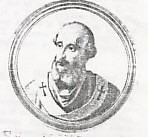 On the death of John XVII, Crescentius III secured the election
of another John--John Phasanus. John Phasanus was a Roman of the Metrovian Gate
district. His father, Ursus, had become a priest. John himself was cardinal of
St. Peter's. It is uncertain whether it was St. Peter's in the Vatican or St.
Peter-in-Chains. John seems to have been a man of excellent character. He was
consecrated on Christmas Day, 1003, under the title of John XVIII. Stirring
events took place in this pontificate as Ardoin, the last independent medieval
King of Italy, strove vainly to hold his kingdom against the attacks of Emperor
Henry II.
On the death of John XVII, Crescentius III secured the election
of another John--John Phasanus. John Phasanus was a Roman of the Metrovian Gate
district. His father, Ursus, had become a priest. John himself was cardinal of
St. Peter's. It is uncertain whether it was St. Peter's in the Vatican or St.
Peter-in-Chains. John seems to have been a man of excellent character. He was
consecrated on Christmas Day, 1003, under the title of John XVIII. Stirring
events took place in this pontificate as Ardoin, the last independent medieval
King of Italy, strove vainly to hold his kingdom against the attacks of Emperor
Henry II.
Crescentius seems to have kept the Pope from taking any part in
this struggle. John XVIII, however, did accomplish some things in the
ecclesiastical sphere. He seems to have put an end to an obscure Eastern schism.
For some reason not known, Constantinople had revolted from Rome in the last
years of the tenth century. Now in the pontificate of John XVIII the breach was
healed and Constantinople once more returned to Catholic unity. If John XVIII
had been unable to help Henry II in his Italian campaign, he did work closely
with the pious Emperor in his German affairs. Henry, like the Ottos, relied on
churchmen to balance the power of the turbulent lay lords. He now revived the
see of Merseburg which had been suppressed in the reign of Otto II. Henry also
wished to establish a new see at Bamberg to serve as a base for missionary
activity among the Slavs. In both of these matters Pope John cooperated closely.
In France the Pope came to the rescue of Goslin, abbot of Fleury.
The archbishop of Sens and the bishop of Orleans were both
trying to make the abbot give up his papal privilege of exemption. The Pope took
this seriously. He sent the bishop of Piperno into France to investigate the
matter, and he ordered the offending bishops to come to Rome and give an account
of themselves. John also gave the pallium to Meingaudus, archbishop of Trier,
and to Alphege, archbishop of Canterbury. In the temporal sphere, he set up salt
works near Porto. But John's pontificate was not easy. Plague and famine
desolated Rome, and to add to the misery, Saracens operating out of Sardinia
ravaged the coasts.
The end of John's pontificate is interesting but obscure. It
seems that he abdicated and retired to become a monk in the Monastery of St.
Paul- Outside-the-Walls. He died shortly afterwards, probably in the summer of
1009.
Excerpted from "Popes
Through the Ages" by Joseph Brusher, S.J.

